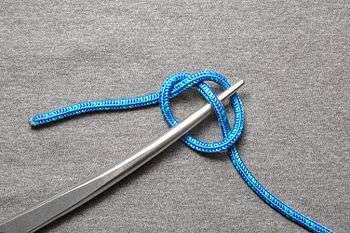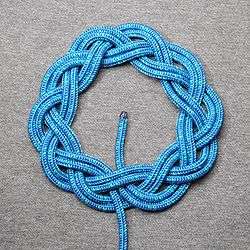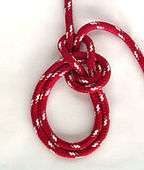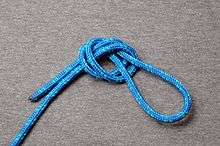Bight (knot)

An open loop (ABoK #31) of rope, narrower than a bight.
In knot tying, a bight is a curved section or slack part between the two ends of a rope, string, or yarn.[1] "Any section of line that is bent into a U-shape is a bight."[2] An open loop is a curve in a rope narrower than a bight but with separated ends.[3] The term is also used in a more specific way when describing Turk's head knots, indicating how many repetitions of braiding are made in the circuit of a given knot.[4]
Slipped knot
In order to make a slipped knot (also slipped loop and quick release knot), a bight must be passed, rather than the end. This slipped form of the knot is more easily untied. The traditional bow knot used for tying shoelaces is simply a reef knot with the final overhand knot made with two bights instead of the ends. Similarly, a slippery hitch is a slipped clove hitch.
In the bight
The phrase in the bight (or on a bight) means a bight of line is itself being used to make a knot. Specifically this means that the knot can be formed without access to the ends of the rope.[5] This can be an important property for knots to be used in situations where the ends of the rope are inaccessible, such as forming a fixed loop in the middle of a long climbing rope.
Many knots normally tied with an end also have a form which is tied in the bight (for example, the bowline and the bowline on a bight). In other cases, a knot being tied in the bight is a matter of the method of tying rather than a difference in the completed form of the knot. For example, the clove hitch can be made "in the bight" if it is being slipped over the end of a post but not if being cast onto a closed ring, which requires access to an end of the rope. Other knots, such as the overhand knot, cannot be tied in the bight without changing their final form.
Examples
| Bight examples |
|---|
| The final tuck of this slipped buntline hitch is made with a bight rather than the end, making it easier to release after tightening. |
| In the tying of a marlinespike hitch, a bight of the standing part is snagged through the loop. |
| The bights, in the case of this 3-lead 10-bight Turk's head knot, are the scallops along the perimeter of the knot. |
|
References
- ↑ Ashley, Clifford W. (1944). The Ashley Book of Knots. New York: Doubleday, 1944, p597. ISBN 9780385040259.
- ↑ Budworth, Geoffrey (2002). The Illustrated Encyclopedia of Knots, p.18. ISBN 9781585746262.
- ↑ Ashley (1944), p13.
- ↑ Ashley (1944), p232.
- ↑ Ashley (1944), 207.
Bibliography
- Ashley, Clifford W. (1944). The Ashley Book of Knots. New York: Doubleday, 1944. ISBN 9780385040259.
- Budworth, Geoffrey (2002). The Illustrated Encyclopedia of Knots. ISBN 9781585746262.
External links
 |
Wikimedia Commons has media related to Bights. |
|
|---|
|
|
|
|
|
| |
|---|
| | Lists of knots | |
|---|
| | Related topics | |
|---|
|
|
|
|








